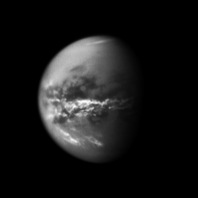
Spring showers on Titan
DR EMILY BALDWIN
ASTRONOMY NOW
Posted: 21 March 2011


The Cassini spacecraft has spotted the first evidence for methane rain soaking the surface around equatorial regions of Saturn's moon Titan.
Cassini observed an arrow-shaped storm developing in the moon's equatorial regions in late September last year (the equivalent of April on Titan), followed by short-lived changes on the surface – an area spanning 500,000 square kilometres darkened as a result of being wetted by the methane rain.


An arrow-shaped storm blows across the equatorial region of Titan in late September (left). A few weeks later clouds have concentrated at Titan's equator (right), marking a change in seasons following the equinox in August 2009. Image: NASA/JPL/Space Science Institute.
“Titan continues to surprise and amaze us,” says Alfred McEwen, a planetary scientist at the University of Arizona’s Lunar and Planetary Lab. “After years of dry weather in the tropics, an area the size of Arizona and New Mexico combined was darkened by methane rain over a period of just a few weeks.”
Titan's methane-rich weather systems form as part of an Earth-like water cycle, with methane-filled lakes present in the moon's polar regions. Until now, it was uncertain whether methane rains were responsible for some of the surface features seen in the equatorial regions. Since the Saturnian system experienced equinox – the point when the Sun lies directly over a planet's equator – in August 2009, it appears that seasonal changes are finally underway in those equatorial regions.
“These outbreaks may be the Titan equivalent of what creates Earth’s tropical rainforest climates, even though the delayed reaction to the change of seasons and the apparently sudden shift is more reminiscent of Earth’s behavior over the tropical oceans than over tropical land areas,” comments Cassini Imaging Team member Tony Del Genio of NASA’s Goddard Institute for Space Studies.
Tropical rain clouds on the Earth are present year-round and only shift slightly with the seasons, whereas on Titan it seems that these tropical storms only dominate near the equinoxes. How the situation evolves will be closely followed by the imaging team as the seasons change from spring into northern hemisphere summer.
|



